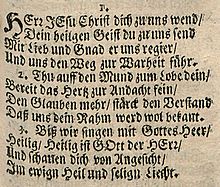Lord Jesus Christ, turn to us
Lord Jesus Christ, turn to us is a Lutheran hymn from the 17th century, which has long been one of the most popular German-language Protestant hymns. The ö -lied is first in the Evangelical Hymn book in the section Divine Service - Entrance and Exit (No. 155), in Praise of God under the heading Mass Chants - Chants for the Opening (No. 147) and in the Mennonite Hymn book under the heading Celebrating Divine Service (No. 2) included.
Text transmission
The three-verse lyrics can be found in the Lutherisch Hand-Büchlein by Johannes Niedling ( Altenburg 1648). The trinitarian doxology (verse 4) is added to the Gotha hymn book of 1651, but not in the later editions of Niedling's hand booklet. Niedling himself can be considered as the author. However, since 1676 Wilhelm von Sachsen-Weimar (1598–1662) is given as the author.
Form and content
The stanza form with four eight-syllable, iambic , masculine rhyming lines corresponds to the classic Ambrosian hymn scheme.
The song is a request to Jesus Christ for the Holy Spirit as a guide on the "path to truth" (verse 1) and for the ability to praise Christ and understand him more deeply (verse 2) to the point of perfection in the sacred song the angel (verse 3).
Text in use today
1. Lord Jesus Christ, turn to us,
send your Holy Spirit to us;
with help and grace he rules us and guides
us on the way to truth.
2. Open your mouth to praise yourselves, prepare your
heart for devotion, increase your
faith, strengthen
your understanding so that your name will be well known
to us , 3. until we sing with God's army:
“Holy, holy is the Lord God! “
And see you face to face
in everlasting joy and blissful light.
4. Honor be to the Father and the Son,
the Holy Spirit in one throne;
to the Holy Trinity
be praise and glory forever.
melody
With the in today's hymn books is the date "Gochsheim / Redwitz 1628". However, this information is based on uncertain evidence. The earliest surviving print can be found in the Görlitz hymn book Pensum Sacrum (1648) for a Latin text. In the Gotha Cantionale Sacrum from 1651, the melody is assigned for the first time to the text Herr Jesu Christ, dich zu uns wend ; the four-part cantional movement by an unknown author, which was included in the Evangelical Hymnbook (No. 155), is also added to it.
The melody gets its happy "welcome" character from the triad motif at the beginning and the 6/4 time alternating between 2 × 3 and 3 × 2 rhythm. This time signature was abandoned in the 18th century - the numerous arrangements from this period, especially by Johann Sebastian Bach ( BWV 632, 655, 726, 749), assume a straight-time melody version - but reintroduced in the 20th century.
Trivia
"A lieutenant thought he was funny when he got up at a cheerful table, at which the superintendent was also present, and emptied his glass, which had been filled for the umpteenth time, with the following shouting:
- Lord Jesus Christ, turn to us -
- Long live the superintendent!
The celebrated rose instantly and went on cheerfully in the lyrics:
- Faith more, strengthen the mind -
- Long live the lieutenant! "
translation
Catherine Winkworth translated the song into English in 1863 under the title Lord Jesus Christ, be present now .
literature
- Andreas Marti : 155 - Lord Jesus Christ, turn to us . In: Martin Evang, Ilsabe Seibt (Hrsg.): Liederkunde zum Evangelischen Gesangbuch . No. 20 . Vandenhoeck & Ruprecht, Göttingen 2015, ISBN 978-3-525-50343-0 , p. 3–8 , doi : 10.13109 / 9783666503436.3 ( limited preview in Google Book search).
Web links
- Free scores of Lord Jesus Christ, join us wend in the Choral Public Domain Library - ChoralWiki (English)
Individual evidence
- ↑ Joseph Theodor Müller (Ed.): Hymnological Handbook for the Hymn Book of the Brethren (= Erich Beyreuther et al. (Ed.): Nikolaus Ludwig von Zinzendorf : Materials and Documents. Series 4, Volume 6). Gnadau 1916. Reprint: Olms, Hildesheim 1977, ISBN 3-487-06358-1 , p. 141 ( limited preview in the Google book search).
- ↑ in Niedling "Lieb", also in Gotteslob 2013
- ↑ in Niedling "Heil"
- ↑ Markus Jenny : The origin information in the church hymn book . In: Zwingliana , 14, 1978, pp. 493-525, here p. 503; zwingliana.ch (PDF; 2.02 MB). Printed in: Jahrbuch für Liturgik und Hymnologie , 24, 1980, pp. 53-68 ( JSTOR 24201104 ).
- ↑ The verifiable sources of text and melody are precisely summarized in A New Hymnal for Colleges and Schools . Yale University Press, Yale 1992, ISBN 0-300-05113-1 , for the English version Lord Jesus Christ, be present now No. 339 ( limited preview in Google book search).
- ↑ Theologians spit and fun. Hardly 400 Christian and unchristian jokes . Hamburg 1973, p. 31
- ↑ Lord Jesus Christ, be present now . Hymnary.org. Retrieved July 1, 2016.
- ↑ Lord Jesus Christ, be present now on Lutheran-Hymnal.com
